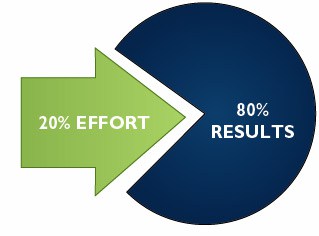
Simple: By following Pareto’s Principle. (also known as the 80–20 rule, the law of the vital few, and the principle of factor sparsity) Named after Italian economist and sociologist Vilfredo Pareto.
The rule simply states: 80% of our results come from 20% of our activity.
Wikipedia Definition :
The Pareto principle (also known as the 80–20 rule, the law of the vital few, and the principle of factor sparsity) states that, for many events, roughly 80% of the effects come from 20% of the causes. Vilfredo Pareto, who observed in 1906 that 80% of the land in Italy was owned by 20% of the population; Pareto developed the principle by observing that 20% of the pea pods in his garden contained 80% of the peas.[2]
It is a common rule of thumb in business; e.g., “80% of your sales come from 20% of your clients”. Mathematically, the 80-20 rule is roughly followed by a power law distribution (also known as a Pareto distribution) for a particular set of parameters, and many natural phenomena have been shown empirically to exhibit such a distribution.
You may have heard that we wear 20% of our clothes 80% of the time, this same 80/20 rule applies to your business.
For instance, 80% of your sales come from 20% of your customers, affiliates, reps (whatever you call them in your industry) Conversely, 80% of your complaints, questions and problems come from 20% of your customers, and 80% of the profits made in your industry come from 20% of the companies.
Of course the numbers can be slightly different like 85/15% or 75%/25% but you get the idea.
By identifying your key reps or catering to your key customers and areas that are most valuable to you and your business, you can boost your bottom line without working longer or harder. In fact, you’ll be working smarter. At the same time as you’re finding your most profitable areas, you also need to think about those customers or products that are not performing well and may actually be dragging down you and your business.
Identifying Key Players

Increase the prices on the ones flying off the shelf to determine if price is a factor with your buyers, and keep the others low to either sell them off quickly or make a price change across the board for all your pieces to increase the value of your inventory.
Identifying key players in a product driven business is just as important as identifying key players in a “person driven” business such as MLM’s or Network Marketing where your bottom line is also effected by those working with and under you.
The rule still applies. 20% of your team will produce 80% of the results, this group will be self starters, motivated and finding answers to their questions before they reach out to you. When you do connect with them, they are in action and always learning. While the other 80% will need the most attention and produce less than 20%.
Here are some areas to consider in your own business:
*Affiliates/Team Members – Who is your rock star team member and what can you do to help them achieve even better results? Keep an open door for these people that come with a solution to their questions and are eager for feedback. This is a hand up not a hand out relationship. Next, look at who is underperforming and what they may need to increase their confidence for success. Not everyone is created equal, so how can you assist those that are not quit in the 20% yet but want to be?
There is a fine line between empowering someone to step up their game and holding their hand. There is a time when you have to let them walk on their own and realize that there is a high rate that they will fall off, or take a new direction. Both outcomes must be expected.
*Clients – Calculate how much revenue you’re getting from each client and subtract the cost of administrative time or other costs to maintain that relationship. Once you’ve figured out which clients are in your top 20%, you can make some strategic decisions about how to better meet their needs.
*Markets & Marketing – If you sell products to different markets or are targeting a different niche, evaluate these markets with the same principle you used for evaluating your customers. The markets that are earning you the most money should become obvious, so you can start examining the direction you want to continue moving toward or shift altogether.
 Trimming the Fat
Trimming the Fat
Once you’ve identified areas that aren’t paying off, you have to take action and “trim the fat.” Your business cannot flourish if you’re spending valuable time and resources on customers or products that are unprofitable. Once you make the strategic decision to cull wasted time and focus on areas that earn more money, you’ll have a much better chance of surviving—and flourishing—in a competitive business environment.
This may sound harsh, but it has to be addressed. If you have products, customers , team mates or even marketing campaigns that are not carrying their weight, you have to focus on those that are.
Question: Can you identify where you need to trim the fat in your business?
Share below. I am interested to hear what you come up with.

Excellent article and I agree completely. Many people get really upset when it is suggested leaders should only give time to those worthy of their time, but it is true. There are so many people that want results without doing work and no matter how much extra time you spend with them (or do for them), it will not change them into a producer. That is something that we absolutely need to recognize. The suggestion to check to see who (of the bottom) is really working, but just not there yet, perfectly handles the objections to not giving everyone an equal chance. Some people are slower but still will shine and produce once they have it all figured out and are ready for that. As a matter of fact, those that do take the extra time to learn and grow themselves first, just might end up being some of your best producers. 😉
I am passionate about helping others and absolutely want to be involved with and help my team as much as possible, but I simply don’t have time to do any hand holding and know my upline does not either. My business time (and theirs) is for building business and learning the skills needed to be better for self AND the team. Spending time holding 1000’s of hands really takes away from individual, team and business growth as well as the “freedom” we are ALL working for in the first place.
Again, excellent article. Thanks for sharing.
Thanks for sharing this interesting information! It may help me when I need to trim the fat!
Torsten @ http://www.mightytravels.com